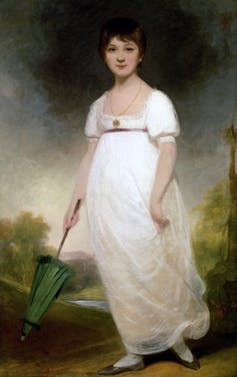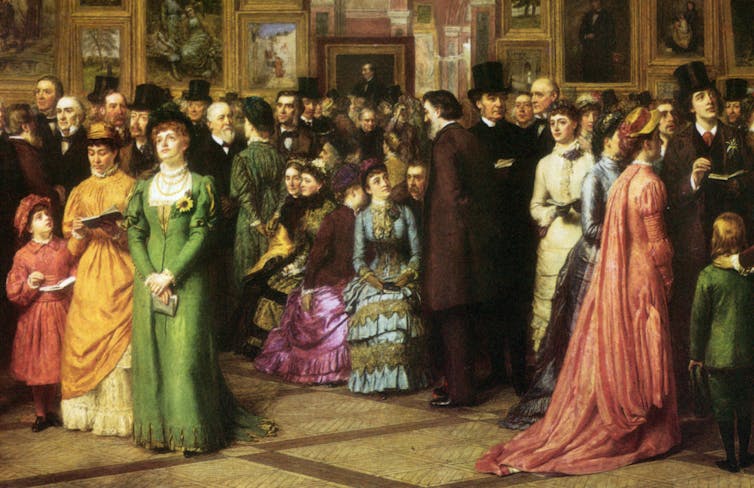Writing with a quill pen dipped in ink, sitting in the flickering of candlelight in a book-lined study, and vintage tweed paired with knitted jumpers and brogues have all become the height of fashion for autumn 2021.
Known as dark academia, this trend has brought the hallowed halls of ancient universities to the digital worlds of TikTok and Instagram. On Instagram, the tag #darkacademia now has over 1 million posts, and Grazia has named the aesthetic as autumn 2021’s biggest trend. The TikTok generation has keenly embraced the tweedy cosiness of scholarly life.
Centred around an idealised experience of studying at European and North American universities, this romanticised lifestyle of learning emphasises knowledge, culture and literature. In fashion, it is expressed through a hybrid of historicism and Victoriana, vintage country wear and thrifted clothing.
But this is not the first time that dressing to look clever has been in vogue. Performing intellectualism through dress has been on trend for centuries. Here, we will explore five of the most intellectual fashion trends in history.
1. The Bluestockings
The term “bluestocking” came to be used as a derisive term for intellectual women, but its origins are more fashionable.
The Blue Stocking Society was founded in the 1750s in England by Elizabeth Montagu, known as Queen of the Blues, alongside other ladies of the Georgian elite. Unsurprisingly, there had been few opportunities for women to discuss classical literature, politics, and philosophy within the glittering ballrooms and drawing rooms of 18th-century England. Frustrated at women’s intellectual starvation, this group of fashionable ladies met to discuss these topics.
Blue stockings were part of the relaxed, informal wear that the group wore to their gatherings. Unlike the glimmering sheen of the white or black silk stockings of high fashion, the rustic simplicity of blue worsted wool stockings was seen as informal and intimate, and a symbol of their rejection of the sartorial expectations of high society.
One bluestocking, the novelist Frances Burney, recalled that a potential attendee who did not have fashionable clothes suitable for a formal evening occasion was told: “Don’t mind dress! Come in your blue stockings!”
2. Dressing Like a statue
During the 18th century, the classical worlds of ancient Greece and Rome were rediscovered by Europe’s intellectual elites.

From architecture to literature, neo-classicism became the fashion. Projects like the excavation of Pompeii ignited the European imagination about this romanticised classical past. Inspired by the recovered statues of women dressed in elegant drapery, fashionable ladies cast off their stays and hoops to mimic these classical half-nude statues.
This rather impractical drapery was transformed into the respectable, high waisted, white muslin gowns familiar to modern audiences through Jane Austen productions. Resembling a tall, column-like statue was all the rage.
3. Romanticism
From billowing shirt sleeves to tousled locks of hair, the sartorial aesthetic of the Romantic poets like Lord Byron, Percy Bysshe Shelley, and John Keats is evoked in dark academia itself. Romanticism championed ideals over convention and is epitomised by the melancholy, intelligent, and brooding Byronic hero archetype.
The gothic and historically inspired aesthetics of Romanticism spread to fashion, which adopted features such as medieval slashing (a technique in which the outer fabric is cut to reveal another colourful silk beneath) and Tudor-esque neck ruffles. These fantastical styles, which reimagined and sentimentalised history, spread from an intellectual desire to overthrow neoclassicism in favour of resplendent Renaissance history.
4) Dress reform and artistic dress
The late 19th century saw a series of intellectual revolutions in dress, which rejected the restrictions and formality of Victorian high fashion. In the 1850s, women’s rights activist Amelia Bloomer began a trend among women reformists of wearing large baggy trousers, now known to us as bloomers.
Baggy trousers may have swiftly gone out of style, but Victorian intellectuals continued to invent new fashions that reflected their academic principles.

Spearheaded by the pre-Raphaelites, artistic dress, also known as Künstlerkleid, called upon romantic medievalism and rejected the structured drapery of Victorian high fashion. In line with the hand-crafted aesthetics and ethics of the Arts and Crafts movement, the fashion was for flowing loose gowns and gothic trimmings. The aim was to look like you had stepped out of the pre-Raphaelite portrait of an Arthurian lady.
5) Philosophes
In the early 20th century, French philosophers and popular playwrights alike propelled the turtleneck into the spotlight as the anti-establishment, intellectual garment of the age. From Audrey Hepburn in Funny Face to philosopher and accidental style icon Michel Foucault, the turtleneck was the epitome of cerebral style.
More recently embraced by Apple co-founder Steve Jobs, the clean lines of the turtleneck employed sartorial simplicity to both counter and embody the busy brain. Sharp and sleek dressing reflected modern innovation and creative genius.
In 2021, dark academia is both comforting and clever. For a generation that grew up awaiting their letter from Hogwarts, but who now find themselves learning online, it is perhaps unsurprising that today’s young people have made their imagined landscapes of turrets, tweed and tea in the online space of social media.





























